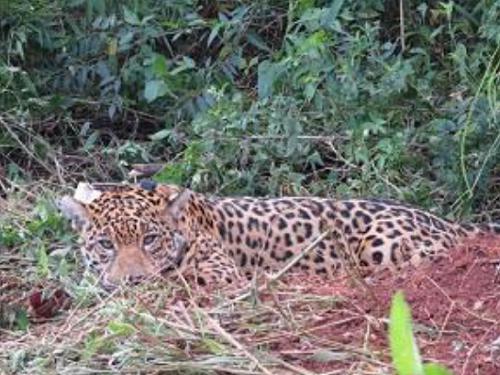Agustin Paviolo
Other projects
17 Jan 2004
Jaguar (Panthera onca) Densities in the Atlantic Forest of Argentina: Its Relationship with Prey Availability, Hunting Pressure and the Presence of Pumas (Puma concolor) I
29 Dec 2007
Jaguar (Panthera onca) Densities in the Atlantic Forest of Argentina: Its Relationship with Prey Availability, Hunting Pressure and the Presence of Pumas (Puma concolor) II
Since 2003 we have been conducting research and conservation activities on jaguars in the Atlantic Forest of Argentina. In 2008 we start new conservation oriented-research related with inter-specific relationships between jaguars and pumas, and population dynamics, habitat requirements and health population of jaguars to improve a Conservation Plan for the jaguars in the region.

The Upper Paraná Atlantic Forest is one the most endangered ecoregions in the world, with 7% of its original area remaining. Misiones province of Argentina and neighbouring areas of Brazil, contains the Green Corridor, which is the largest continuous remnant of this forest on Earth. This area contains the southernmost jaguar population in the world.
Since 2003 with support of Rufford Small Grants Foundation and many others governmental and nongovernmental organizations we are carrying out this project that is aimed at assessing the status and threats of this jaguar population. Between 2003 and 2008, our goals were focused on the estimation of the jaguar population of the Green Corridor and the evaluation of the impact of poaching of jaguars and its preys. Our results served as the basis for a population viability analysis that suggests that this jaguar population, estimated in 25-53 individuals, is critically endangered. Simultaneously, we developed collaboration with government and nongovernment institutions to develop a Conservation Plan for this population and large scale education campaigns promoting jaguar conservation in the area.
The next step of our project is to obtain population dynamics parameters, habitat and landscape use information and identified some potential threats and thus generate knowledge to improve the conservation plan. Since 2008 we started new conservation-oriented research aimed at:
1) estimating jaguar population dynamics by camera-trap surveys in the North of Misiones (area already surveyed in 2004, 2006 and 2008). The repetition of surveys in the same area at regular intervals will serve to monitor jaguar population trends and estimate turn-over rate.
2) Understanding how landscape features affect jaguar persistence and its genetic variability. From jaguar presence data and landscape variables, we will elaborate statistical habitat models that will identify the landscape factors that best describe the species’ distribution and spatial structure, and will be useful to predict population changes in relation to different potential landscape scenarios.
3) evaluating the mechanism of coexistence between jaguars and pumas by fitting these animals with GPS-collars to learn how they use their habitat and studying its diets under different conservation regimes to understand the interaction of poaching and intra-guild competition.
4) evaluating the potential impact of diseases in the conservation of this jaguar population and identify health threats from domestic carnivores in the area. The results of our research will be used to improve the Conservation Action Plan for this endangered jaguar population.